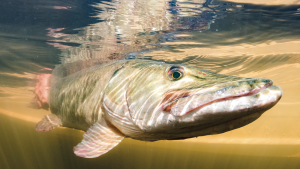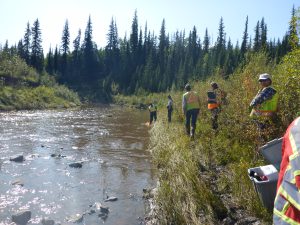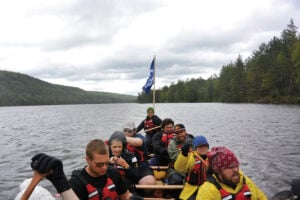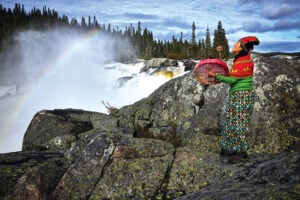
Environment
Space invasion: Is it too late to save the Great Lakes?
How a cocktail of invasive species and global change is altering the Great Lakes-St. Lawrence River ecosystem
- 2231 words
- 9 minutes
People & Culture
Announcing a new initiative to connect to and protect the Great Lakes-St. Lawrence watershed
In the embrace of the Great Lakes-St. Lawrence watershed, we find ourselves guardians of a global treasure: the planet’s most expansive freshwater ecosystem. The sheer diversity of life interwoven within this natural tapestry is nothing short of miraculous. But with the privilege of residing in this blue heartland comes an inherent duty to protect and sustain it. This is the essence of the Biinaagami initiative — our call to action to honour the waters that cradle life in its myriad forms.
Biinaagami — a term bestowed upon this initiative by Anishinaabek grandmothers Barbara Nolan and Donna Debassige of Mnidoo Mnising (“Island of the Great Spirit” or Manitoulin Island) — translates to “clean, pure waters” in Anishinaabemowin. It stands as a testament to our undertaking, not just in name but in spirit. The grandmothers’ wisdom implores us to recognize water’s soul, its nurturing feminine energy, and to engage with it through reverence and respect. They urge us to adopt a “two-eyed seeing” philosophy, harmonizing Indigenous and western sciences, ensuring our actions are guided by a comprehensive and inclusive vision for the Great Lakes-St. Lawrence watershed.
Understanding that the path to safeguarding our waters is paved with mutual respect and collaboration is fundamental. Love fuels protection — and grand-scale endeavors demand unity. The Great Lakes-St. Lawrence watershed is home to 40 million people across various sovereign nations, transcending the binary narrative of a region divided between Canada and the United States. Indeed, over 200 First Nations and Tribes hold sway over this vast aquatic expanse, making our collective mission all the more poignant.
For millennia, the Original Peoples of the watershed have borne witness to the land’s metamorphosis, adapting to the whims of nature. Yet, in recent centuries, the Great Lakes have borne the brunt of exploitation, desecration, and disjointed stewardship. Now, as we face burgeoning populations, developmental pressures, and the pervasive threat of climate change, our shared responsibility to devise a strategy for a sustainable, clean water future has never been more critical.
Our shared responsibility to the Great Lakes
Biinaagami
Biinaagami is a collaborative, interdisciplinary and multimedia project aimed at restoring and protecting the environmental and cultural sustainability of the Great Lakes region.
We must dispel any notion that our lakes are beyond salvation. Such defeatism breeds apathy and paves the way for further degradation. Recall the era of the “rust belt,” a term that once echoed through our political arenas, hinting at industrial decline. Yet, it also kindled a fiery resolve among us to become custodians of these waters.
Now, a formidable coalition emerges — champions of water from diverse walks of life, including a former Grand Chief, Indigenous education advocates, Waterkeepers, Riverkeepers and Anishinaabek and Haundenosaunee Elders and Knowledge Keepers — united with Canadian Geographic and Swim Drink Fish. Together, we present an urgent yet hopeful manifesto to those who dwell within the Great Lakes-St. Lawrence watershed. The time for collaborative action is upon us. It is time to redefine our cultural and economic valuation of water.
Amidst the concerns, hope flourishes. We are witnessing commendable achievements and harnessing knowledge and technologies that are capable of ensuring the vitality of our interconnected wetlands, lakes and rivers. Hope is bred through proactive engagement, born from newfound awareness and comprehension. Through Biinaagami, we aim to invigorate people to learn, connect, care and act.
The journey of learning can start with Canadian Geographic’s Biinaagami giant floor map, an immersive tool allowing you to traverse this majestic watershed to understand its geography, history and cultures. Through augmented reality, this map will serve as a portal to myriad narratives, commencing with the Water Walkers, who exemplify our intimate connection with these waters.
Our commitment to education extends to the development of bilingual, curriculum-based lesson plans, emphasizing a two-eyed seeing approach. These resources are set to enrich schools and communities across the watershed, fostering a new generation of water protectors.
Biinaagami will harness the storytelling prowess of writers, photographers, videographers and musicians to spark curiosity and inspire stewardship. Our vision is for people to unearth the magic in this unique region, to cultivate a sense of belonging — and to collectively act to preserve the aquatic veins that nourish the Great Lakes and St. Lawrence River.
We extend a heartfelt invitation to all individuals, organizations, entrepreneurs, and communities already contributing to this cause to join hands with Biinaagami. Read our declaration, forge connections and amplify your impact at biinaagami.org. Every entity, every citizen, shares the custodial duty to tend to these waters. Our collective might is formidable. Join the movement.

Are you passionate about Canadian geography?
You can support Canadian Geographic in 3 ways:

Environment
How a cocktail of invasive species and global change is altering the Great Lakes-St. Lawrence River ecosystem

Environment
Many of Canada’s 25 watersheds are under threat from pollution, habitat degradation, water overuse and invasive species

People & Culture
How a journey through the Great Lakes helped reshape my relationship with water after the loss of my father

Environment
In February 2021, the world was introduced to Mutehekau Shipu — also known as the Magpie River — when the people of Ekuanitshit, Que. and the regional municipality made a joint declaration granting the river legal personhood and rights. The declaration carries broad implications for the fight to protect nature across Canada and around the world.